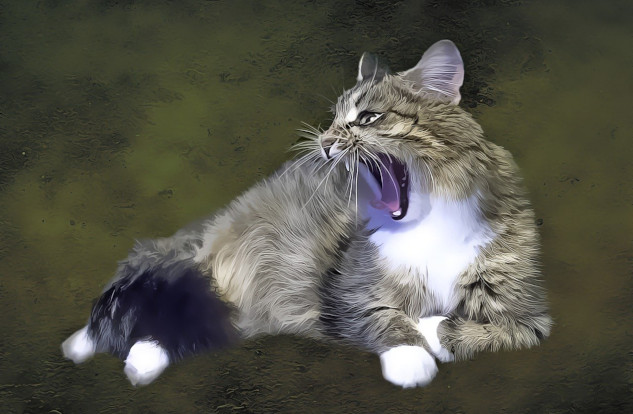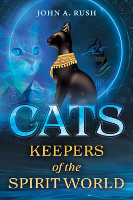
Image by wieniek04 from Pixabay
In this Article:
- How cats evolved from ancient predators to cherished companions.
- Roles cats play as spiritual symbols across cultures.
- Why cats are seen as symbols of both power and mystery.
- How does the history of cat domestication impact our modern-day bond?
- Can understanding the mystical nature of cats deepen our connection to them?
Cats as Spiritual Symbols: Predators or Friends?
by John A. Rush.
For millions of years we’ve had a hate/love relationship with cats. At first, we were their prey, day after day and night after night. In terms of endocellular selection, the fear of being eaten is etched on our genes and was a major factor in our physical and social development.
Our ancient ancestors banded together and developed survival skills centering on bonding and on communication designed to warn of danger. Communication skills, over time, went from hoots and hollers to the languages we use today.
Language as we know it probably developed at least three million years ago and allowed us to store information in the form of symbols that could then be passed from generation to generation, allowing the accumulation of knowledge. In fact, language likely allowed us to leave Africa and collect and store information gathered from experiences in these new environments.
Fear and Adaptation
The predators, especially the cats, were a driving force in our evolution as we adapted over time to their presence and consumption of our friends and relatives. They were adapting to us as well.
Eventually, around three million years ago and through analogous thinking, we began to identify with the cats, fashioning stone tools in the likeness of predator teeth. We used these tools, emulating the scavengers, to secure needed calories during those times when fruits, berries, nuts, tubers, and so on, were in short supply. These tools led to a closer and more positive identity with the cats and other predators—we were becoming them.
Initially cats were the monsters in the night but became saviors, forever changing our beliefs and likely ritual practices. Now, as in the past, we recognize and honor these monsters (both the good and the bad) by incorporating them in our narratives, myths, and homes.
Our ancient ancestors were not only participants but observers of their world, and through their observation they identified the spiritual nature of cats and the physical characteristics and behaviors we saw in ourselves, or, at the very least, admired and desired.
As we were adapting to the predators, the cats, in this case, were adapting to us, observing our behaviors including our physical abilities and limitations, knowing how to sneak up and remain motionless, to blend in with the scenery and patiently waiting for a meal; they were often successful.
Ape bipedalism emerged sometime in the late Miocene, perhaps as much as eight to ten million years ago (or even earlier). Bipedalism made our ancient ancestors seem larger than they were—a choice, no doubt, that helped to deter some predation. Nonetheless whether bipedal or quadrupedal, meat was necessary for the cat’s survival, and, Dinofelis barlowi, an archaic leopard, dined on our bipedal Australopithecine cousins in South Africa frequently (Brain 1981).
Neanderthals and Modern Humans As Predators
With the thrusting and throwing spears developed between eight hundred and five hundred thousand years ago, Neanderthals and modern humans became apex predators, and although still taken as prey, such technology can turn the tables, which obviously it did. Let me add that a “whacking” stick might have been used for millions of years to protect from predators while on the ground and preceded the spears that were jabbed or thrown.
I notice with our cats, both inside and outside, when I have a rake, broom, or similar object in my hands, even the domesticated cats will show caution. That caution cannot be a learned behavior in our household; we don’t whack our cats. Instead this behavior is likely etched on their genes.
A heavy stick can inflict a great deal of damage to a cat, as can a well-placed stone. Throwing a stone accurately requires a special shoulder joint, and I am not sure when this showed up—likely before the erectus-types of around two million years ago.
The Domestication of Cats
Researchers have suggested that domestication of the cat took place in at least two areas, the Levant and Egypt, as it is in these areas where we first encounter agriculture (Levant) and herding of cattle (Levant and Egypt). In order for animal domestication to take place the human agency first needs a reason for doing so. Animals used as foodstuff, fur, or protection are obvious enough.
The cat, on the other side, is not so easy to justify outside of its capacity to kill and eat mice. This has led some to speculate that the cat domesticated itself. The question is why? The answer may lie in that ancient relationship of prey vs. predator and the connection between us and our ancestors as food.
Although Felis chaus, Felis silvestris lybica, and Felis catus do not normally eat our kind these days, that deep epigenetic connection would push them to at least be around us, and doing so provided them food, first perhaps in the form of mice in both the agricultural setting and in cattle herding, and later in our purposefully feeding cats just to keep them around.
Folklore and Myth
Folklore and myth paint a diverse picture of the cat, from demon and trickster to an intelligent being sympathetic toward human kind. In more current renderings of the cat we encounter Catwoman in the Batman series, who is a composite of raging Sekhmet and Bastet in her disposition.
The cat has become an archetype, not as a cat etched on our genes in the Jungian sense, but an image connected to fear—fear of the night, injury, and death. The domesticated cat is perhaps a reminder of those early days, millions of years ago, when we served as their food and, of course, we still do—although we serve “ourselves” out of a can of paté or bag of kibble.
Modern movies have continued to promote the image of the cat as both devil and angel, trickster and matchmaker in the same way as we see the Celtic and Japanese imaginings. Power seems to be the main characteristic attached to cats, first the big cats, the lion, tiger, leopard, jaguar, and only later Felis.
Cats over time have become our companions, our children, and for many people they take the place of human interaction. This is especially the case for older people whose relatives and friends are deceased and the energy required to attain new relationships becomes bound to their pets and television.
Cat As A Power Symbol
The word cat is a symbol and, contrary to a sign, can point in many directions at the same time. The symbol, in its own way, is like the waveform that supports the tangible universe in that it can represent many things. And, like Schrödinger’s Cat, the symbol is in superposition and only becomes “tangible” within a context or situation.
For some the cat is neutral; for others it is a symbol of good, of companionship or luck, while for others the cat is evil, a demon. Regardless, most would agree that the cat symbolizes power—to do good or evil. For the less spiritually inclined, the cat is simply a cat.
The cat, however, is difficult to ignore—they can be big, powerful, and ruthless and urinate on your back porch or sofa, and they can be cute, cuddly companions. If we take these general characteristics back in time, we can identify our fear of cats and all that goes bump in the night.
And if you look to more recent times, when we became indebted to these animals for our survival, we can appreciate the cat’s dual personality. In more modern times still, we have enclosed the characteristics or symbols of power, protection, companionship, and cute and cuddly within our art forms, which will serve to honor cats in the millennia to come.
Copyright 2023. All Rights Reserved.
Adapted with permission of Destiny Books,
an imprint of Inner Traditions Intl.
Article Source:
BOOK: Cats
Cats: Keepers of the Spirit World
by John A. Rush. Exploring the spiritual nature of cats, John A. Rush looks at humanity’s fascination and fear of cats through the ages. He examines spiritual and occult beliefs connected to cats from Mayan, Aztec, and Native American mythology as well as from ancient India, Samaria, Babylon, Japan, and Egypt, including how ancient Egyptians used cats to send messages to the gods. He also explores similarities between cat and human emotions, cat communications with us, and the deep connection between cats and meditation...
Exploring the spiritual nature of cats, John A. Rush looks at humanity’s fascination and fear of cats through the ages. He examines spiritual and occult beliefs connected to cats from Mayan, Aztec, and Native American mythology as well as from ancient India, Samaria, Babylon, Japan, and Egypt, including how ancient Egyptians used cats to send messages to the gods. He also explores similarities between cat and human emotions, cat communications with us, and the deep connection between cats and meditation...
For more info and/or to order this book, click here. Also available as an Audiobook and a Kindle edition.
 About the Author
About the Author
John A. Rush, Ph.D., N.D.,is a retired professor of anthropology and naturopathic doctor. He is the author of many books, including Spiritual Tattoo, The Twelve Gates, and The Mushroom in Christian Art, as well as the editor of several books, including Entheogens and the Development of Culture.
Visit his website at: ClinicalAnthropology.com/
Article Recap:
This article explores the fascinating duality of cats as ancient predators and spiritual companions. It traces the journey of cat domestication, examining how cats went from fearsome night stalkers to symbols of companionship, power, and mystery. The article delves into cultural beliefs, folklore, and the spiritual symbolism surrounding cats, discussing how our bond with them continues to evolve. This complex relationship captures our instincts, embodying both fear and admiration for these enigmatic creatures.
More books by this Author.

























